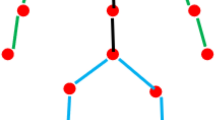Abstract
The accuracy evaluation method of sports training is not high due to factors such as light and angle, and the accuracy of sensor recognition methods is not high. Therefore, this article designs and develops a method for evaluating the accuracy of sports training movements based on a grating ruler displacement sensor and joint recognition algorithm, in order to improve the accuracy and stability of the evaluation. Research on connecting the grating ruler displacement sensor to the joint site, collecting real-time displacement data of the joint, and preprocessing the collected data to improve data quality. For the collected displacement data, joint recognition algorithms are used for analysis and processing. By extracting and comparing joint features, the collected displacement data is matched with the preset action mode to obtain accurate action recognition results. Based on the results of action recognition, accuracy evaluation is based on various indicators, such as the completeness, accuracy, and stability of actions, to obtain the evaluation results for the accuracy of sports training actions. The evaluation results can be provided to coaches or athletes to evaluate the effectiveness of training, identify problems, and make adjustments.






Similar content being viewed by others
Data availability
The data will be available upon request.
References
Cao, Z., Xu, L., Feng, J.: Automatic target recognition with joint sparse representation of heterogeneous multi-view SAR images over a locally adaptive dictionary. Sig. Process. 126, 27–34 (2016)
Chu, C., Ge, Y., Qian, Q., Hua, B., Guo, J.: A novel multi-scale convolution model based on multi-dilation rates and multi-attention mechanism for mechanical fault diagnosis. Digit. Signal Proc. 122, 103355 (2022)
Gao, Z., Xuan, H.Z., Zhang, H., Wan, S., Choo, K.K.R.: Adaptive fusion and category-level dictionary learning model for multiview human action recognition. IEEE Internet of Things J. 6(6), 9280–9293 (2019)
He, Y., Zhong, Y., Wang, L., Dang, J.: GLFormer: global and local context aggregation network for temporal action detection. Appl. Sci. 12(17), 8557 (2022)
Heere, B.: Embracing the sportification of society: Defining e-sports through a polymorphic view on sport. Sport Manage. Rev. 21(1), 21–24 (2018)
Heinecken, D.: Empowering girls through sport? Sports advice books for young female readers. Children’s Literat. Edu. 47, 325–342 (2016)
Li, C., Cui, J.: Intelligent sports training system based on artificial intelligence and big data. Mob. Inform. Syst. 2021, 1–11 (2021)
Ma, C., Shou, M.: Sports competition assistant system based on fuzzy big data and health exercise recognition algorithm. Mob. Inform. Syst. 2021, 1–10 (2021)
Oderov, A., Romanchuk, S., Fedak, S., et al.: Innovative approaches for evaluating physical fitness of servicemen in the system of professional training. J. Phys. Educ. Sport. 17, 23 (2017)
Van der Kruk, E., Reijne, M.M.: Accuracy of human motion capture systems for sport applications; state-of-the-art review. Eur. J. Sport Sci. 18(6), 806–819 (2018)
Wang, P.: Research on sports training action recognition based on deep learning. Sci. Program. 2021, 1–8 (2021)
Wang, J., Li, J.: Human skeleton key point detection method based on OpenPose-slim model. J. Comput. Appl. 39(12), 3503 (2019)
Wang, C., Liu, Z., Chan, S.C.: Superpixel-based handgesture recognition with Kinect depth camera. IEEE Trans. Multimed. 17(1), 29–39 (2014)
Wang, L., Huynh, D.Q., Koniusz, P.: A comparative review of recent Kinect-based action recognition algorithms. IEEE Trans. Image Process. 29, 15–28 (2019)
Wang, J., Tan, S., Zhen, X., Xu, S., Zheng, F., He, Z., Shao, L.: Deep 3D human pose estimation: a review. Comput. Vis. Image Underst. 210, 103225 (2021)
Wang, Q., Zhang, K., Asghar, M.A.: Skeleton-based ST-GCN for human action recognition with extended skeleton graph and partitioning strategy. IEEE Access. 10, 41403–41410 (2022)
Wu, L., Ren, H.: Finding the kinematic base frame of a robot by hand-eye calibration using 3D position data. IEEE Trans. Autom. Sci. Eng. 14(1), 314–324 (2016)
Yadav, M., Alam, M.A.: Dynamic time war** (dtw) algorithm in speech: a review. Int. J. Res. Electron. Comput. Eng. 6(1), 524–528 (2018)
Zhu, L.: Computer vision-driven evaluation system for assisted decision-making in sports training. Wirel. Commun. Mob. Comput. 2021, 1–7 (2021)
Funding
This work was sponsored in part by National Natural Science Foundation of China (2345678).
Author information
Authors and Affiliations
Contributions
LL has contributed to the paper’s analysis, discussion, writing, and revision.
Corresponding author
Ethics declarations
Conflict of interest
The authors declare that they have no competing interests.
Ethical approval
Not applicable.
Additional information
Publisher’s Note
Springer Nature remains neutral with regard to jurisdictional claims in published maps and institutional affiliations.
Rights and permissions
Springer Nature or its licensor (e.g. a society or other partner) holds exclusive rights to this article under a publishing agreement with the author(s) or other rightsholder(s); author self-archiving of the accepted manuscript version of this article is solely governed by the terms of such publishing agreement and applicable law.
About this article
Cite this article
Li, L. Accuracy evaluation of sports training actions based on grating ruler displacement sensor and joint recognition algorithm. Opt Quant Electron 56, 554 (2024). https://doi.org/10.1007/s11082-023-06246-x
Received:
Accepted:
Published:
DOI: https://doi.org/10.1007/s11082-023-06246-x




